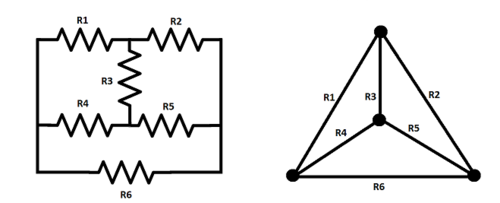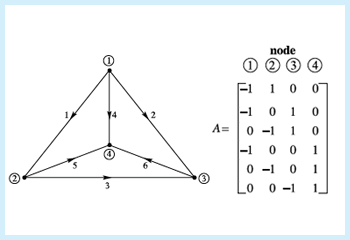Problem Solving
Linear algebra can be used to solve large ohmic circuits. This page explains how to define the circuit problem in terms of a linear system that can be solved with computational methods like matlab or python.
The Main Idea
We can describe an electrical circuit as a graph where the nodes represent specific points and the edges represent the components connecting them. E.g:

Incidence Matrix
The incidence matrix, A, is a matrix of dimensions m x n, where m is the number of edges and n is the number of nodes. If x is the vector that contains all the nodes in order, A satisfies: [math]\displaystyle{ A\vec{x}_{edge} = x_{end} - x_{start} }[/math] Thus, the resulting matrix will have zeros in every element of each row, except for the start and the end nodes, which will be -1 and 1 respectively:

Here, [math]\displaystyle{ x_{1}, x_{2}, x_{3} }[/math] and [math]\displaystyle{ x_{4} }[/math] represent the voltages at the nodes. Then [math]\displaystyle{ A\vec{x}_{edge} = x_{end} - x_{start} }[/math] gives the voltage differences [math]\displaystyle{ ∆V }[/math].
Loop Rule (Kirchhoff's voltage law)
Using this creative way of transforming a circuit to a graph and getting the incidence matrix from it allows us to do some interesting things. Kirchhoff's loop rule is a principle of conservation of energy that implies that the directed sum of the voltage differences around any closed network is zero.
This means that the components of [math]\displaystyle{ A\vec{x} = b }[/math] add to zero around every loop. Moreover, the voltage law can decide whether b is in the column space of A.
We know from Ohm's law that [math]\displaystyle{ V = I * R }[/math]. Then, in the previous graph for example, we would have that [math]\displaystyle{ V_{edge1} = I * R = (direction) * R_{1} = 1 * R_{1} }[/math].
Kirchhoff's Current Law
We know from Kirchhoff's law that the sums of the currents in each node is zero. This means that the current flowing into the node is the same as the current flowing out of the node. Therefore the multiplication of each column of A by the current vector, y, must be equal to zero:
[math]\displaystyle{ A^{T}\vec{y} = 0 }[/math]
where [math]\displaystyle{ y_{i} }[/math] is the current passing through edge [math]\displaystyle{ i }[/math].
Examples
Be sure to show all steps in your solution and include diagrams whenever possible
Simple
Middling
Difficult
Connectedness
- How is this topic connected to something that you are interested in?
- How is it connected to your major?
- Is there an interesting industrial application?
See also
Are there related topics or categories in this wiki resource for the curious reader to explore? How does this topic fit into that context?
Further reading
Books, Articles or other print media on this topic
External links
Internet resources on this topic
References
- Strang, G. (2016), Introduction to Linear Algebra, Wellesley-Cambridge Press, 5th edition, isbn:978-0-9802327-7-6